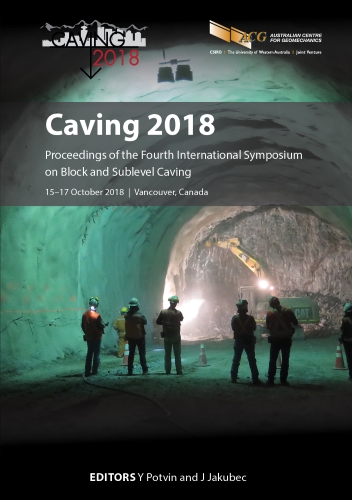Suggested methods for estimation of confined strength of heterogeneous (defected) rocks

|
Authors: Bahrani, N; Kaiser, PK; Corkum, A |
DOI https://doi.org/10.36487/ACG_rep/1815_13_Bahrani
Cite As:
Bahrani, N, Kaiser, PK & Corkum, A 2018, 'Suggested methods for estimation of confined strength of heterogeneous (defected) rocks', in Y Potvin & J Jakubec (eds), Caving 2018: Proceedings of the Fourth International Symposium on Block and Sublevel Caving, Australian Centre for Geomechanics, Perth, pp. 207-222, https://doi.org/10.36487/ACG_rep/1815_13_Bahrani
Abstract:
A grain-based model based on the distinct element method previously calibrated to the laboratory properties of intact and heat-treated (granulated) marble is used to simulate grain-scale heterogeneities, such as grain boundary cracks and laboratory specimen-scale heterogeneities (often referred to as defects), such as veins. The semi-empirical Strength Degradation Approach (SDA), originally developed for the estimation of the confined strength of crack-damaged rocks, is first applied and tested for the estimation of confined strength of laboratory specimen-scale rocks and rock blocks containing defects. In the second approach, called the explicit numerical modelling approach, the grain-based model is integrated with discrete fracture network (DFN) models, to construct defected rock models and to investigate the influence of defect orientation on the confined strength of defected rocks. It is concluded that the SDA can be used at the early stages of geotechnical projects, when limited information on the properties and geometrical characteristics of defects is available. The explicit numerical modelling approach provides more representative results than the SDA, as it requires a detailed knowledge of the properties of intact rock as well as the properties and geometrical characteristics of defects obtained from field mapping and laboratory testing. A step-by-step procedure is provided for the application of these two methods to estimate the confined strength of defected rocks.
Keywords: heterogeneity, defects, rock block strength, Strength Degradation Approach (SDA)
References:
Bahrani, N & Kaiser, PK, 2013, ‘Strength degradation of non-persistently jointed rock mass’, International Journal of Rock Mechanics and Mining Science, vol. 62, pp. 28–33.
Bahrani, N & Kaiser, PK 2016a, ‘Strength degradation approach (SDA) for estimation of confined strength of micro-defected rocks’, Proceedings of the 50th US Rock Mechanics/Geomechanics Symposium, American Rock Mechanics Association, Alexandria.
Bahrani, N & Kaiser, PK 2016b, ‘Integrated grain-based-DFN model for simulation of defected rock’, in P Gomez, C Detournay, R Hart & M Nelson (eds), Proceedings of the 4th Itasca Symposium on Applied Numerical Modeling, Itasca International Inc., Minneapolis, pp. 303–314.
Bahrani, N & Kaiser, PK 2016c, ‘Numerical Investigation of the influence of specimen size on the unconfined strength of defected rocks’, Computers and Geotechnics, vol. 77, pp. 56–67.
Bahrani, N & Kaiser, PK 2017, ‘Estimation of confined peak strength of crack-damaged rocks’, Rock Mechanics and Rock Engineering, vol. 50, no. 2, pp. 309–326.
Bahrani, N, Kaiser, PK & Valley, B 2014, ‘Distinct element method simulation of an analogue for a highly interlocked, non-persistently jointed rock mass’, International Journal of Rock Mechanics and Mining Sciences, vol. 71, pp. 117–130.
Gerogiannopoulos, NG 1976, A Critical State Approach to Rock Mechanics, PhD thesis, University of London, London.
Jaeger, JC & Cook, NGW 1976, Fundamentals of Rock Mechanics, Chapman and Hall, London.
Kaiser, PK & Kim, B 2015, ‘Characterization of strength of intact brittle rock considering confinement-dependent failure processes’, Rock Mechanics and Rock Engineering, vol. 48, no. 1, pp. 107–119.
Laubscher, DH & Jakubec, J 2000, ‘The MRMR rock mass classification for jointed rock masses’, Underground Mining Methods: Engineering Fundamentals and International Case Studies, Society for Mining, Metallurgy & Exploration, Englewood,
pp. 475–481.
Laubscher, DH 1975, ‘Class distinction in rock masses’, Coal, Gold, Base minerals South Africa, vol. 23.
Laubscher, DH 1990, ‘A geomechanics classification system for the rating on rock mass in mine design’, Journal of the Southern African Institute of Mining and Metallurgy, vol. 90, no. 10, pp. 257–273.
Martin, CD 1993, The Strength of Massive Lac du Bonnet Granite Around Underground Openings, PhD thesis, University of Manitoba, Winnipeg.
Medhurst, TP & Brown, ET 1998, ‘A study of the mechanical behaviour of coal for pillar design’, International Journal of Rock Mechanics and Mining Science, vol. 35, no. 8, pp. 1087–1105.
Potyondy, DO 2010, ‘A grain-based model for rock: approaching the true microstructure’, Proceedings of Bergmekanikk i Norden 2010: Rock Mechanics in the Nordic Countries, Norsk Bergmekanikkgruppe – Tekna, Kongsberg.
Potyondy, DO 2012, ‘A flat-jointed bonded-particle material for hard rock’, Proceedings of the 46th US Rock Mechanics Symposium, American Rock Mechanics Association, Alexandria, paper ARMA12-501.
Rosengren, KJ & Jaeger, JC 1968, ‘The mechanical properties of a low-porosity interlocked aggregate’, Geotechnique, vol. 18, no. 3, pp. 317–326.
Yang, SQ, Jiang, YZ, Xu, WY & Chen, XQ 2008, ‘Experimental investigation on strength and failure behaviour of pre-cracked marble under conventional triaxial compression’, International Journal of Solids and Structures, vol. 45, no. 17, pp. 4796–4819.
© Copyright 2025, Australian Centre for Geomechanics (ACG), The University of Western Australia. All rights reserved.
View copyright/legal information
Please direct any queries or error reports to repository-acg@uwa.edu.au
View copyright/legal information
Please direct any queries or error reports to repository-acg@uwa.edu.au
